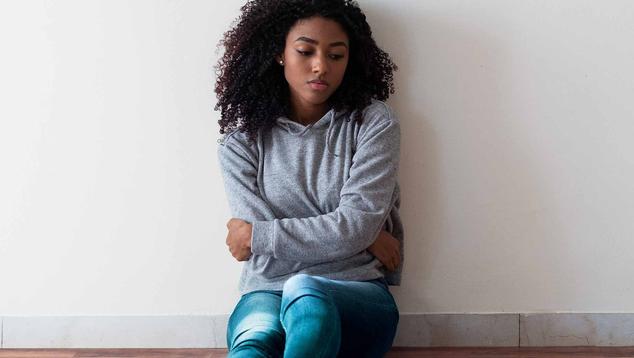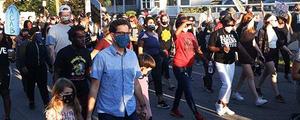Story Highlights
- Black life ratings in 2020 rank among worst since 2008
- Life ratings for Hispanic adults drop to lowest level since 2009
- Daily stress, worry level off at elevated points
WASHINGTON, D.C. -- The percentage of Black Americans who evaluate their lives well enough to be considered "thriving" has eroded since 2016, dropping to 48.1% in 2020. This is down nearly 10 percentage points since the recorded high mark of 57.9% in 2010 and is down five points since 2016. These results are based on new data from the Gallup National Health and Well-Being Index, which began measurement in 2008.
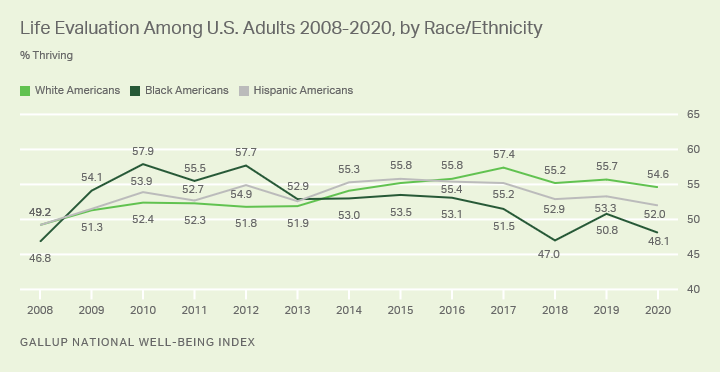
Line graph. The percentages of Americans who are classified as thriving from 2008 through 2020, by race and ethnicity. 54.6% of White Americans are classified as thriving, compared with 52% of Hispanic Americans and 48.1% of Black Americans.
After improving to 57.4% in 2017, the percentage of White adults classified as thriving has since held steady around 55% in the years since, roughly matching levels found in 2015-2016. Hispanic adults, in turn, have slid 3.4 points since 2016 to 52.0%, the lowest thriving level since 2009. Of the three groups, Hispanic Americans have had the most stable thriving percentages since the Well-Being Index measurement began in 2008.
The most recent results, captured July 30-Sept. 3, 2020, is based on 2,321 U.S. adults surveyed by mail and web.
Gallup classifies Americans as "thriving," "struggling" or "suffering" according to how they rate their current and future lives on a ladder scale with steps numbered from 0 to 10, based on the Cantril Self-Anchoring Striving Scale. Those who rate their current life a 7 or higher, and their anticipated life in five years an 8 or higher, are classified as thriving.
In 2008, the first full year of the Great Recession, the overall U.S. thriving percentage for the full year was 48.9%, improving to 51.6% in 2009 and 53.2% in 2010. While White and Hispanic adults improved modestly during this two-year period, Black Americans provided the greatest lift to the overall upturn, gaining about 11 percentage points from 46.8% to 57.9%, perhaps in part in response to the historic election of Barack Obama to the presidency. Later, about half of this improvement had eroded during Obama's second term.
Overall Thriving Percentage Holds Steady at Lower Level
Amid a general erosion in life ratings among Black and Hispanic Americans since 2016, the mercurial movement of the thriving percentage in 2020 over the course of the COVID-19 pandemic has now leveled off around 53% since early June, in line with earlier national web polling from the Gallup Panel. This follows a nearly 10-point drop from the spring of 2019 to late April 2020 when the thriving percentage fell to 46.4%, matching its previous lowest level from November 2008.
Testing has shown highly convergent results in the national thriving estimates between the Gallup Panel and the Gallup National Health and Well-Being Index, allowing for comparability.
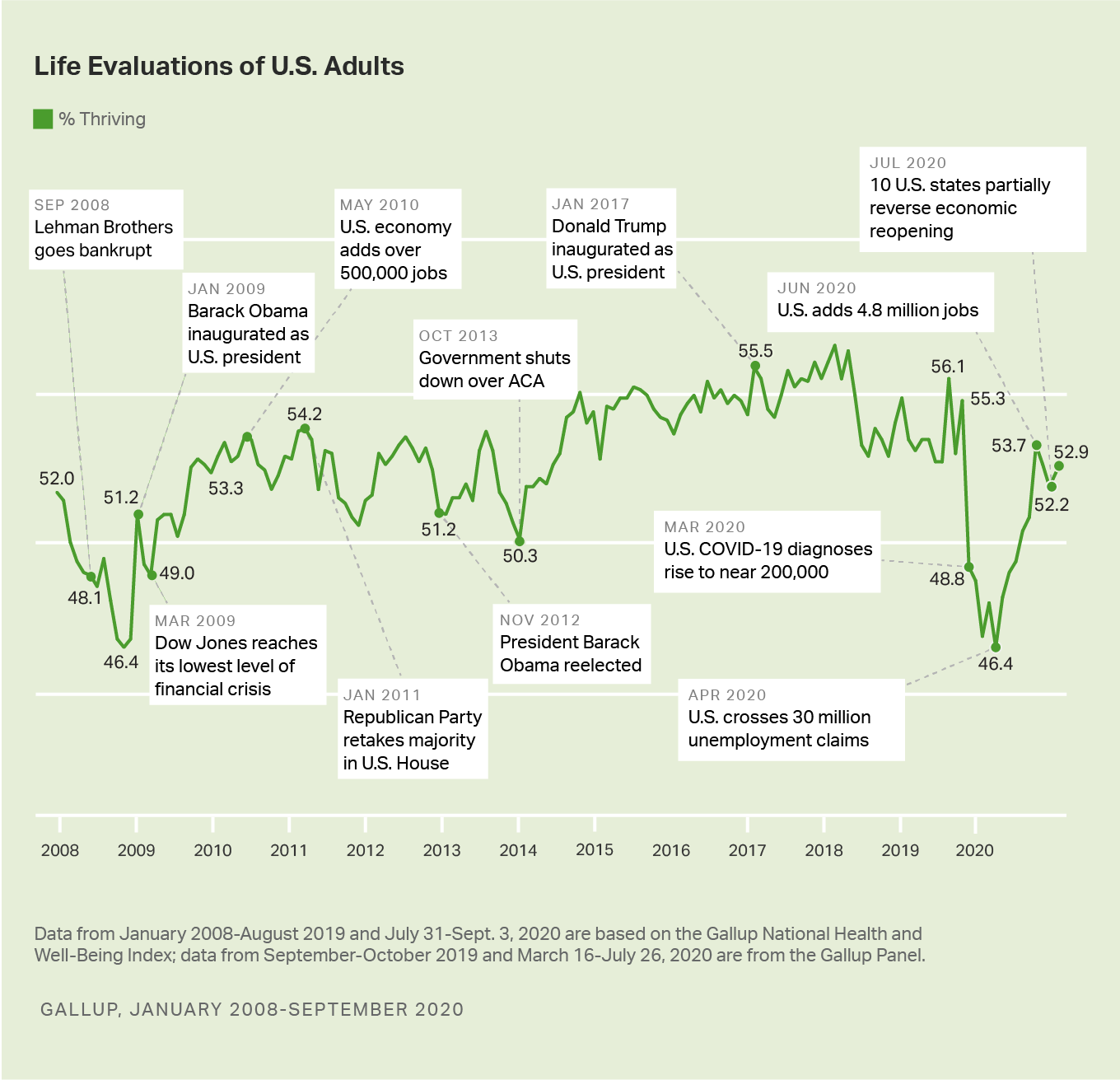
Line graph. The percentages of Americans classified as thriving from 2008 to 2020. Currently, 52.9% of Americans are now classified as thriving.
COVID-Era Spikes in Daily Stress and Worry Continue to Recover
Gallup also tracks whether Americans have experienced specific emotions, including stress and worry in their daily life.
The percentage of people who reported experiencing significant stress and worry the day before showed unprecedented increases in the first half of March, with stress rising 14 percentage points to 60% and worry rising 20 points to 58%. Experiences of these emotions have subsequently leveled off at an elevated level in the months since. The most recent estimates now show significant daily stress still being experienced by 55% of the adult population, about one-third of the way recovered to pre-COVID levels. Daily worry, in turn, is current estimated to be experienced by 47%, recovered about one-half of the way.
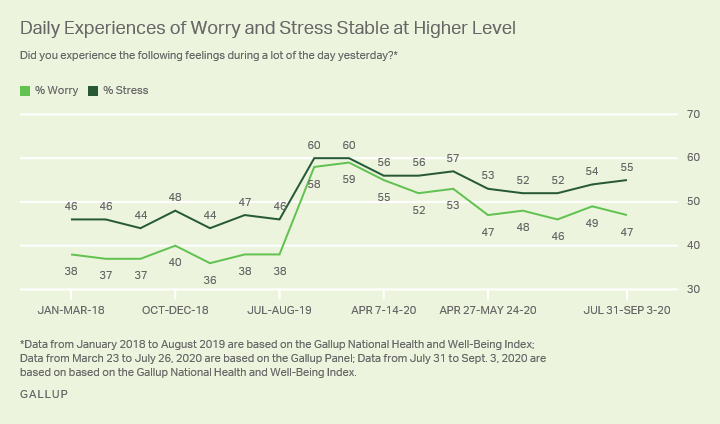
Line graph. The percentages of Americans who experience worry or stress yesterday. 55% of Americans report having experienced stress yesterday, and 47% say they experienced worry.
Implications
The national decline in the Well-Being Index score in 2017 was driven by significant drops among Black and Hispanic Americans. (The Well-Being Index score includes the ladder questions but also many more metrics across five elements of wellbeing.) This drop occurred even as key economic metrics closely related to wellbeing improved during the same period, including unemployment, perceptions of standard of living, confidence in the economy and optimism about spending, and was ultimately characterized by an unprecedented decline in 21 states compared to the year before.
Prior research had shown an additive effect in both race and political identity in how various U.S. subgroups changed the way that they evaluated their lives in the aftermath of regime changes in the presidency. Black Democrats, followed by White Democrats, reported the greatest jump in thriving percentages in the two years following the inauguration of Obama while White Republicans reported a decline during the same period.
In a year that suffered the dual effects of a global pandemic coupled with domestic racial unrest primarily catalyzed by the killing of George Floyd, it is unsurprising that the thriving percentage now is suppressed compared with last year for White, Black and Hispanic adults alike. For Black Americans in particular, however, the decline in general life ratings since 2016 is particularly acute and points to assessments of this group's quality of life that stand apart from the other two groups.
Belief among Black adults, for example, that their children will have as good a chance as White children in the same community to get a good education has reached an all-time low, as has a belief in racial equality in affordable housing. And only 59% of U.S. adults report that the civil rights of Black adults have improved in their lifetime -- down from 87% just seven years earlier -- while 82% of Black Americans now believe that new civil rights laws are needed, up from 53% during the same period of time.
Learn more about how the Gallup National Health and Well-Being Index works.
Learn more about how the Gallup Panel works.
